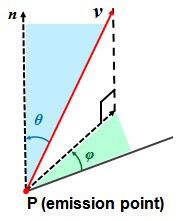

 Particle Sources
Particle Sources Particle Source on PEC
Particle Source on PEC Explosive
Explosive Edit
Edit Particle Sources
Particle Sources Particle Source on any Surface
Particle Source on any Surface Explosive
Explosive Edit
Edit Particle Sources
Particle Sources Particle Point Source
Particle Point Source Explosive
Explosive Edit
Edit Particle Sources
Particle Sources Particle Circular Source
Particle Circular Source Explosive
Explosive Edit
Edit
Energy type
Select the kinetic type, for which the value is specified. Possible values are listed below:
|
Velocity: |
|
|
Velocity in Terms of Speed of Light: |
|
|
Lorentz Factor: |
|
|
Normed Momentum: |
|
|
Energy: |
|
|
Temperature: |
|
Energy value
The emission speed value in respect to the selected energy type. For some energy types there are upper and/or lower limits e.g. Beta must not be larger or equal to 1.
Kinetic spread
The energy spread (in percent) offers the possibility to specify a randomly calculated emission energy. The kinetic emission type (e.g. energy, momentum) is calculated uniformly distributed in the range of:

The kinetic spread is always applied to the selected kinetic type. This means that a kinetic spread of 10% applied to a Beta value leads to another energy distribution as if it would be applied to the equivalent momentum value. Here is an example:
0.9 Beta with a 20% spread leads to a range from 0.81 Beta to 0.99 Beta. This is equivalent to a momentum of 2.065 with a range from 1.381 to 7.018. Note: A uniform Beta distribution does not lead to a uniform momentum distribution.
If the range would exceed a valid limit of an energy type, the interval is restricted:
0.9 Beta with a 30% spread would lead to a range from 0.765 Beta to 1.035 Beta. Obviously this is not physical. The start energies will be uniformly distributed within the range from 0.765 to 1 Beta.
Angular spread
Each particle starts from a triangle in direction of the triangle's normal. Experiments have shown that in reality the emission angle is randomly distributed. Thus it is possible to define an angle in such way that particles are emitted randomly distributed around the normal. By defining a start angle distribution, the theta-angle is randomly chosen between 0 and the maximal start angle. The phi-angle is also randomly chosen between 0-360 degrees.

See also
Particle Emission Model Overview, Secondary Electron Emission Overview
PIC DC Emission, PIC Explosive Emission, PIC Field Emission, PIC Gauss Emission
TRK Field Emission, TRK Fixed Emission, TRK Space Charge Limited Emission, TRK Thermionic Emission